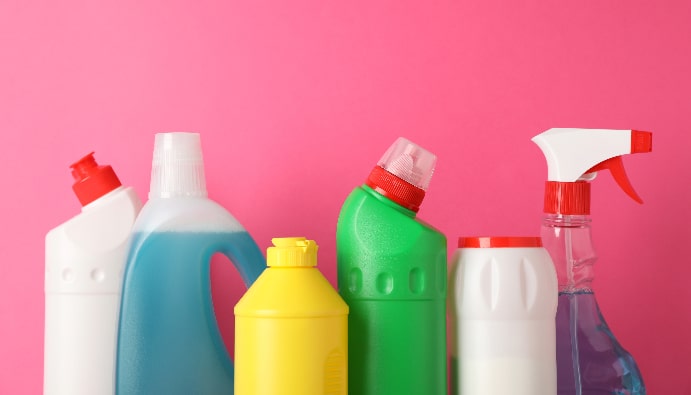Cleaning Products Analysis

Cleaning Products
In our laboratories serving in many parts of Turkey, TURKAK accreditation and international standards, test methods, and related legal regulations based on the analysis of cleaning products in cosmetic products are carried out.
Cleaning Products Analysis
Cleaning products have different ingredients and properties and are subjected to many analyses to ensure their safe and effective use. Below are the main analyses performed on cleaning products and their explanations:
- Appearance: The physical appearance of the product is evaluated by parameters such as clarity, density and consistency. The visual characteristics of cleaning products can directly influence the user's perception of the product.
- Scent: The odor characteristics of cleaning products are important for the effectiveness and pleasant use of the product. Odor tests are conducted to ensure a lasting and pleasant scent.
- Color: The color of cleaning products is an aesthetically evaluated feature by the user and is part of the quality control process.
- Total Active Ingredient: It is a test that measures the amount of active ingredients in cleaning products that determine the cleaning power of the product. This value determines the effectiveness of the product.
- Nonionic Active Substance: Nonionic surfactants have the capacity to dissolve dirt and adhere to surfaces and are important components used in cleaning products.
- Cationic Active Substance: Cationic active ingredients are used primarily in products such as disinfectants and fabric softeners and provide microbial control.
- Anionic Active Substance: Anionic surfactants are usually used in detergents and are components with high dirt-dissolving power.
- Active Chlorine: Active chlorine is a compound used especially in disinfectants that provides the power to kill microorganisms.
- Citric Acid: Citric acid is a compound that provides acidic properties in cleaning products, helping to dissolve mineral deposits.
- Stability: A test that determines whether the physical and chemical properties of cleaning products change over time.
- Long Term Stability: A test of the product's ability to withstand long-term storage conditions and maintain its efficacy.
- Dry Matter: It is the analysis that determines the ratio of non-water, dry substances in the product.
- Acidity: Determines the amount of acidic components in the product and is usually related to the pH value.
- Acid Count: A test that measures the number of free acids in the product and is related to the stability of the product.
- Total Alkalinity: A test that measures the amount of basic (alkaline) components in the product.
- Saponified and Unsaponified Substance: Measures the amount of substances formed as a result of saponification reactions in the product.
- Active Oxygen: Determines the bleaching power in products containing oxygen bleach.
- Free Alkalinity: Measures the amount of free basic components in the product.
- Grammage: Determines the amount of grams per kilogram of product.
- Net Roll: The test that determines the length of the roll in the package.
- Leaf Size: Measures the sheet size of napkin-like products.
- Leaf Width: Measures the width of the leaves in napkin-like products.
- Number of Sheets: Measures the number of sheets in a package of napkin-like products.
- Titration Point of Soaps: Titration test to determine the acidic and basic properties of soap.
- Corrosiveness Determination in Soaps: A test to determine whether soaps damage metal surfaces.
- Foam Amount: A test that measures the amount of foam created by the product during cleaning.
- Determination of Fineness in Toothpaste: Determines the physical properties and fineness of toothpaste.
- Oxygen-Bound Bleach in Detergents: Determines the content and effectiveness of bleaching components.
- Suction Rate (Dishwashing Sponge and Cleaning Cloth): Measures the liquid absorption rate of dish sponges and cleaning cloths.
Hair Dye Analysis
The following tests are carried out for the effectiveness and safety of hair dyes:
- Active Ingredient in Hair Color: Measures the amount of active chemical ingredients in hair dye.
- Peroxide in Hair Dye: Measures the amount of peroxide, the oxidizing agent in hair dye, this component is used to lighten hair.
- Hair Dye pH: Determines the acidic or basic properties of hair dye.
- Evaporation Loss in Hair Dye: Measures the amount of components that evaporate during the application of hair dye.
Cotton Analysis
The following analyzes are performed to determine the quality of cotton and cotton products:
- Soluble Matter in Ether in Cotton Sample: Determines the amount of soluble substances in the cotton sample.
- Heat Effect on Cotton Specimen: Tests the resistance of a cotton sample to heat.
- Cotton Sample Water Absorption and Water Retention: Tests how well the cotton sample absorbs and retains water.
- Submergence of Cotton Sample: Determines the tendency of a cotton sample to sink into water.
- Surfactant in Cotton Sample: Measures the presence of surfactants in a cotton sample.
- Amount of Ash in Cotton Sample: Measures the amount of ash in a cotton sample.
- Moisture in Cotton Sample: Determines the moisture content of the cotton sample.
- Cotton Sample Dyestuff: Measures the amount of dyestuff in a cotton sample.
- Oil and Oily Matter in Cotton Sample: Measures the amount of oil in a cotton sample.

